

AT-2017 Engelsk. AT-2017 "Menneskets forhold til naturen": Begynd her! AT 2017: Menneskets forhold til naturen – Københavns Universitet. Her præsenterer Det Teologiske Fakultet ideer og materialer til arbejdet med AT-opgaver i 2017 under overskriften Menneskets forhold til naturen.
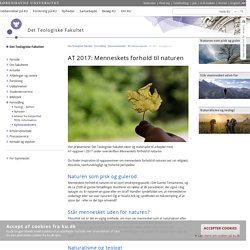
Du finder inspiration til opgaveemner om menneskets forhold til naturen set i et religiøst, filosofisk, samfundsfagligt og historisk perspektiv. Naturen som pisk og gulerod Menneskets forhold til naturen er et stort omdrejningspunkt i Det Gamle Testamente, og de ca 2500 år gamle fortællinger illustrerer en række af de paradokser, der også i dag optager os: Er naturen en gave eller en straf? Handler syndefaldet om, at mennesket er underlagt eller sat over naturen?
Og er Noahs Ark og syndfloden en blåstempling af at spise dyr - eller er det lige omvendt? Står mennesket uden for naturen? Filosofisk set er det en vigtig snitflade, om man ser mennesket som et naturvæsen eller ej. Naturalisme og teologi Er det naturlige godt? God læselyst og held og lykke med opgaven! Diverse forslag.
Eco fiction - incl dystopia & utopia. Cowboys. AT-eksamen 2017 - Forlaget Columbus. Famous American Folktales & Stories from A to Z. Bliv klogere på menneskets forhold til naturen - Religion.dk. Skal du, eller en du kender, skrive AT-opgave om menneskets forhold til naturen?
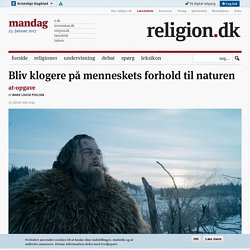
Så har vi her samlet en række artikler til inspiration Hvordan ser moderne mennesker på naturen, hvordan bruger vi naturen, og hvorfor ender vi med at misbruge den? Læs om religionernes forhold til naturen og om det moderne bymenneskes forholdt til naturen i vores store tema her: Menneskets forhold til naturen Naturen i film og bøger Sidste år var det en storfilm om naturen og mennesket, der ryddede Oscarbordet til den store amerikanske filmprisuddeling. Ny storfilm med Leonardo DiCaprio gør et overvældende indtryk Menneskets forhold til dyr Må vi avle dyr for at spise dem? Se vores store tema om dyreetik Dyreforsøg: Der er forskel på rotter og aber Er jagt en blodig hobby eller nødvendig for naturen? Klimaforandringernes betydning for naturen og mennesket Klimaforandringer har været på den globale dagsorden det sidste årti. Hvordan bruger moderne mennesker naturen? Naturen er blevet et statussymbol for mennesket. Frost and Nature. Frost and Nature Frost's use of nature is the single most misunderstood element of his poetry.

Frost said over and over, "I am not a nature poet. There is almost always a person in my poems. " "Spring Pools" and "A Winter Eden" are two rare exceptions to this rule, although both poems embody the idea of perfection - the spring pools "almost without defect" and the snow scene described as "paradise. " Nature does not idealize - that is the work of man, so perhaps there is a person there after all. There is much in nature against us. Poetry Foundation. American Transcendentalism. American transcendentalism was an important movement in philosophy and literature that flourished during the early to middle years of the nineteenth century (about 1836-1860).
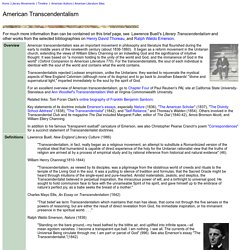
The Walden Woods Project – The Walden Woods Project preserves the land, literature and legacy of the quintessential American author, philosopher, and naturalist, Henry David Thoreau, to foster an ethic of environmental stewardship and social responsibilit. Conflict in Victorian Verse and Prose: Hardy and Others. Introduction The term "conflict," the driving force behind any plot, indicates the clash of wills, desires, goals, tastes, or physical forces that animates the plot of a literary text and generates suspense, thereby engaging the readers in the action of the text as they anticipate the outcome of the conflict.
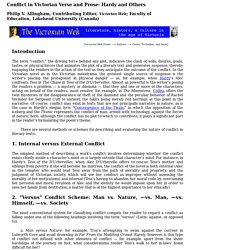
In the Victorian novel as in the Victorian melodrama, the greatest single source of suspense is the writer's placing the protagonist in physical danger — as, for example, when Hardy's Alec confronts Tess in The Chase in Tess of the D'Urbervilles. Almost as powerful is the writer's posing the readers a problem — a mystery or dilemma — that they and one or more of the characters, acting on behalf of the readers, must resolve; for example, in The Moonstone, Collins offers the twin mysteries of the disappearance or theft of the diamond and the peculiar behavior of Rachel Verinder for Sergeant Cuff to unravel, the fakirs being merely red herrings at this point in the narrative. 1. 2. American Studies @ The University of Virginia. A Guide to Outdoor Literature Including New Books, Award Winners & Reading Lists. The Age of Exploration in the Best Children's Books.
Below are the best children's books about the Age of Exploration and famous explorers.

This is an exciting period in World History. In fact, thirty years later, I still remember learning about it as a child in elementary school (and I really wasn't much of a history buff back then.) Below are children's books about the Age of Exploration and some of the key explorers. We couldn't find many books for the younger grades (K-Gr.2) on this era [That's understandable, of course. The 100 Greatest Adventure Books of All Time. Outdoor Literature Reading List. Best Book List: The Outdoor Experience The following is a list of books that I use for an Outdoor Literature class that I teach at Idaho State University.
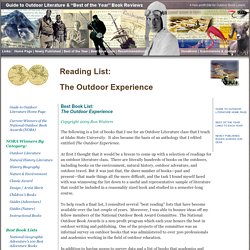
It also became the basis of an anthology that I edited entitled The Outdoor Experience. At first I thought that it would be a breeze to come up with a selection of readings for an outdoor literature class. The Literature of Discovery and Exploration. Contributing Editors: Juan Bruce-Novoa and Carla Mulford Christopher Columbus (1451-1506) Alvar Nuñez Cabeza de Vaca (1490?
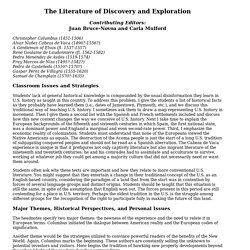
-1556?) A Gentleman of Elvas (fl. 1537-1557) René Goulaine de Laudonnière (fl. 1562-1582) Pedro Menéndez de Avilés (1519-1574) Fray Marcos de Niza (1495? -1542?) Pedro de Casteñeda (1510? Classroom Issues and Strategies Students' lack of general historical knowledge is compounded by the usual disinformation they learn in U.S. history as taught in this country. Students often ask why these texts are important and how they relate to more conventional U.S. literature.
List of books and articles about Travel in Literature. Bliv klogere på menneskets forhold til naturen - Religion.dk. 20 great UK walks with pubs, chosen by nature writers. 1 Grassington, Yorkshire dales Length: 11 milesTime: 5½ hoursStart/finish: Grassington National Park Centre (Google map/OS Explorer OL2)Grade: ModerateRefuel: Craven Arms, Appletreewick Anyone who grows up in or around the Yorkshire dales ends up carrying it with them.
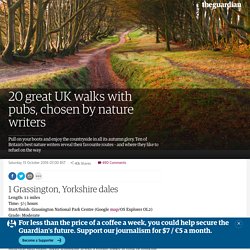
There’s something about the crumpled-duvet landscapes of emerald field and heathery fell, about encountering its sudden, Shire-like valleys threaded with muscular peat rivers, about stumbling across a ruined abbey at dusk or drinking well-earned beers by pub fires that forever sticks in the head and the heart. One of the national park’s greatest pubs has to be the Craven Arms at Appletreewick (mains from £8.95). Read the Tree Leaves, With an Artist's Invented Tree Font. The phrase “about trees,” shown in the font Tree.

The book About Trees, now being reprinted after selling out its first small run last year is, as the title says, about trees. Like other books, it’s also printed on trees, in the form of paper. Unlike any other book, it’s printed in Trees, an arboreal font in which each letter corresponds to a different type of towering plant. Creator Katie Holten, an Irish artist, describes About Trees as a “recycling” of texts that, considered together, provoke much thought about the relationship between humans and nature. The 256-page book contains tree-themed works by prominent authors and other luminaries, from Plato to Radiohead, via Jules Verne, Charles Darwin, and Zadie Smith. A line from Zadie Smith’s novel NW, translated into Tree. We're All a Little Ecosexual. "It's more about breaking down separations between humans and nature. " Photo: Getty Images/iStockphoto Together, Beth Stephens and Annie Sprinkle are perhaps the best-known advocates of ecosexuality, a sliding-scale term used to describe the various interactions of the environment and human sexuality.
Stephens and Sprinkle didn’t coin the word—it was previously used to describe dating an environmentally conscious person—and the basic idea has been around for centuries in various cultures and religions. Supplementary information: Man and Nature in English Literature. Note: supplementary information in italics. 1. The Chain of Being: Nature as a hierarchical system. Modernism and Nature. Savoy Vase, Alvar Aalto (1898 1976), manufactured by Karhula Lasitehtaalla, Karhula, Finland, 1936. Museum no. C.226–1987 During the 1930s many designers and architects, especially the more avant-garde, turned away from mainstream Modernism. Eschewing objectivity, geometry and machine imagery, they shifted their attention to Nature. Here they found organic, curvilinear forms and a more satisfying outlet for their emotional and psychological needs. Nature provided a new guiding principle (the ‘laws of nature’) in which form was derived from function and natural geometry.
Nature and the Romantic Poet - Arts and Humanities. Romanticism was an extensive artistic and intellectual movement, described by Isaiah Berlin as ‘the greatest single shift in the consciousness of the West that has occurred’[1]. Originating in late eighteenth-century Europe, it challenged the Age of Enlightenment’s scientific and rational, objective ideas, and instead promoted the power of individual imagination and subjective experience. Nature was a predominant Romantic theme in the light of the Industrial Revolution, which not only posed a threat to its preservation, but also prompted a rise in local countryside tourism to escape the expanding urban areas. Poets sought to demonstrate this through, as Carl Thompson observes, their ‘appreciation of landscape, and especially of wild or what was often termed “romantic” scenery’[2] in their work.
A presence that disturbs me with the joy Of elevated thoughts; a sense sublime A motion and a spirit, that impels All thinking things, all objects of all thought (94-101) [20]F. . [24]Kenneth R. Romanticism, Nature, Ecology. The connection between Romanticism and ecology has often been recognized in the critical literature on Romanticism and in the writings of ecologists and naturalists. Recently Jonathan Bate, Karl Kroeber, Jim McKusick, Onno Oerlemans, and Kate Rigby have published important books on the subject,[1] and The Wordsworth Circle, Studies in Romanticism, and Romantic Circles Praxis Series have published special issues on the topic.[2] By and large, these books and the articles in the collections argue that we can trace the origins of our current ecological thinking to European Romanticism in general, and sometimes to British and American Romanticism in particular.
A similar trend to link various strands of our current environmental thinking to Romantic ur-texts may be found in the works of environmental historians, geographers, and environmentalists, such as Neal Evernden, Max Oelschlager, I. G. Nature Poems.